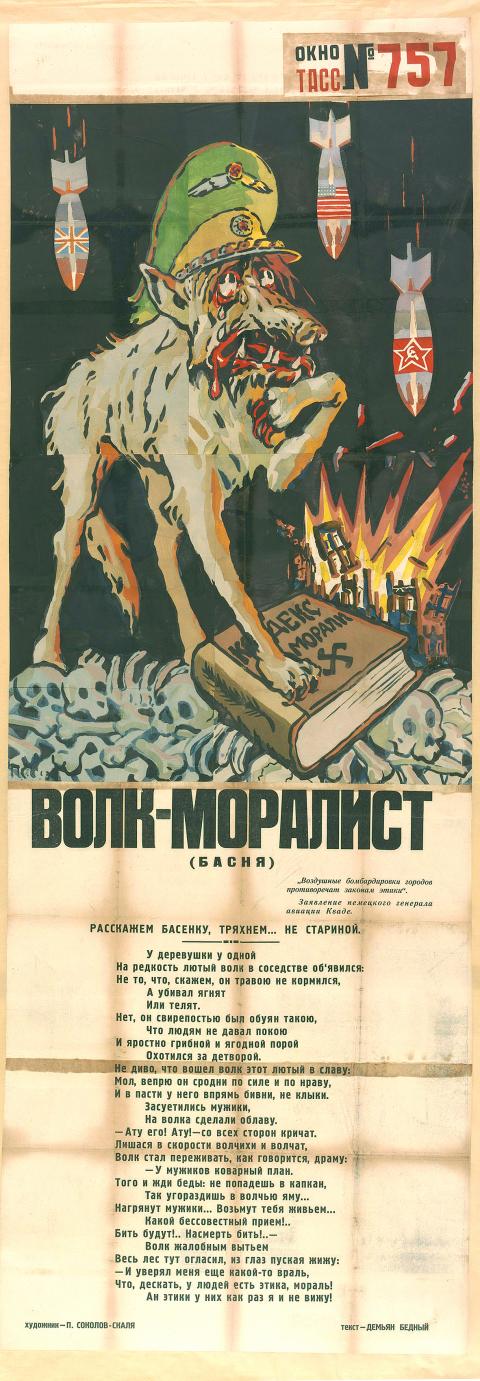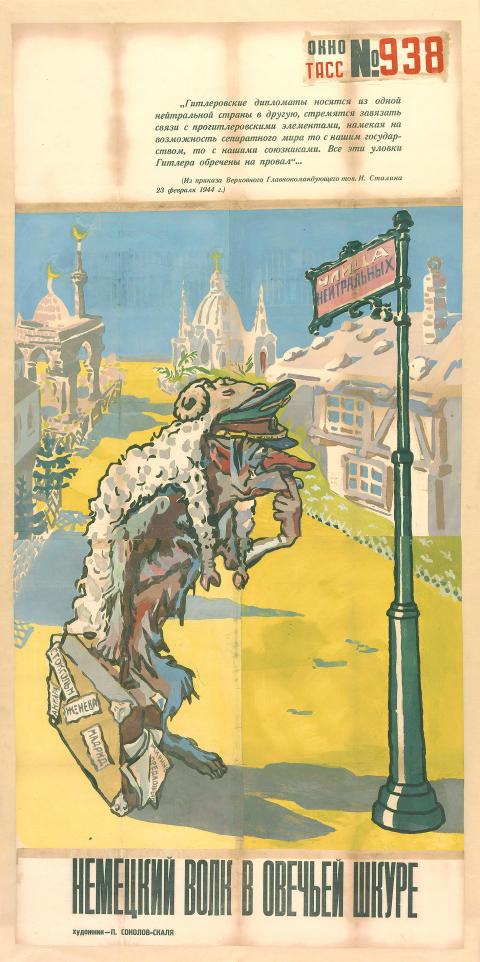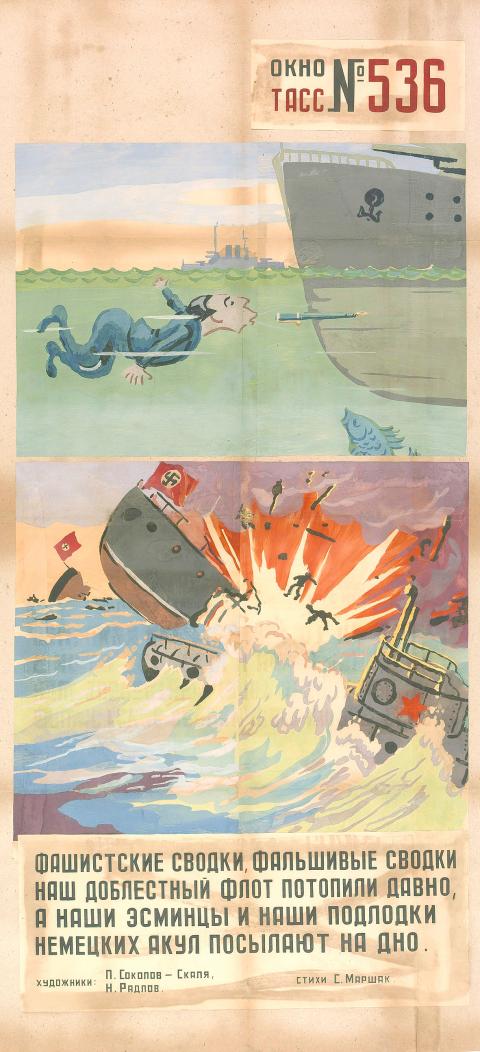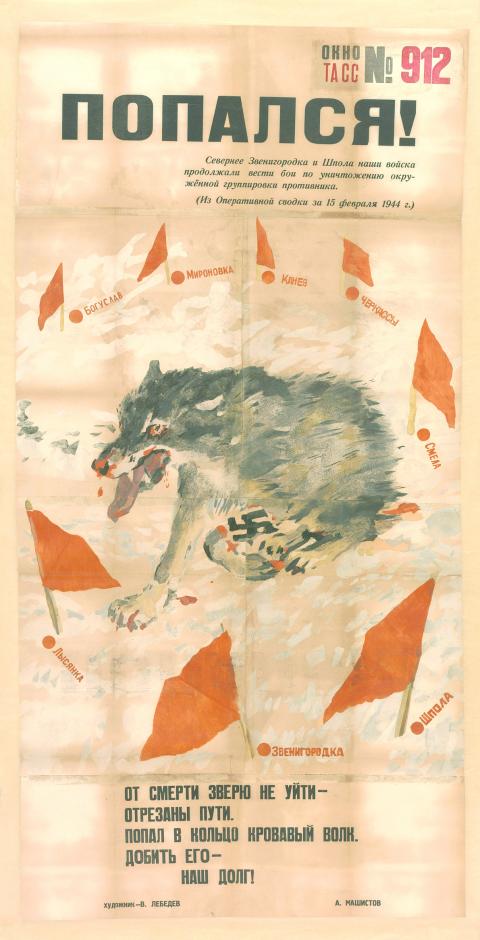The horrors and heroism of World War II are given a fresh look in an Art Institute of Chicago exhibition of rediscovered Soviet propaganda posters that depict Hitler as bloodthirsty, anxious and perverse.
One poster in the Windows on the War exhibition, which opened to the public on Sunday, features a caricature of a worried Hitler hiding a crude hand gesture under his cap while Joseph Goebbels orates nervously.
Another poster produced by Moscow’s TASS studios depicts a fearsome, wolf-like Nazi drooling as Allied bombs fall; and another depicts heroic partisans blowing up a Nazi supply train and firing at escaping soldiers.

Photo: REUTERS
“Despite the tyranny of Stalin, creativity flourished” in the former Soviet Union as artists felt motivated to contribute to the war effort, said Jill Bugajski of the Art Institute, one of the curators of the exhibition of some 250 posters, paintings and mementos that continues through Oct. 23.
“I want the pen to be on par with the bayonet,” wrote poet and poster contributor Vladimir Mahakovsky, who wrote captions and poems that adorned the posters.
A cache of the now-brittle posters were discovered in 1997 sitting on a shelf in one of the Art Institute’s storage closets during a renovation. Two paper rolls and 26 parcels containing the forgotten works were unfolded, restored and some placed behind plexiglass for the exhibition.

Photo: REUTERS
Three hundred artists and writers produced some 1,400 poster designs in Moscow’s TASS studio, which was part of the telegraph and news agency.
Up to 60 stencils were used for each poster, made up of layer on layer of still-bright paint on cheap newsprint. Many of the 800,000 TASS posters produced were lost or forgotten.
They were intended to “create a mood of urgency while visually aggrandizing the Soviet soldier, defining the Nazi enemy as vile and subhuman, and emphasizing the woeful suffering of the Soviet people,” museum exhibitors said.

Photo: REUTERS
Inspired by the prewar mocking of “degenerate art” by the Nazis, who also put on an anti-Bolshevik art exhibition, the Soviet artists took liberties with Communist “social realism” to create shocking, sometimes humorous, images.
The hand-painted posters were distributed to newspapers, museums, libraries and “Russian friendship” societies around the world by the Soviet propaganda operation, the USSR Society for Cultural Relations with Foreign Countries.
Frequently placed in the vacant windows of wartime shops and reprinted in newspapers, the posters have been largely forgotten since the war, curators said.

Photo: REUTERS
Each illustration had its purpose, which seems distant now in light of the subsequent Cold War and today’s up-and-down US-Russia relations: reinforce the Anglo-Soviet alliance against Germany that was signed in September 1941, and lift recruitment and spirits among the beleaguered Allies.
The 157 posters selected for the show offer a diary of the war — from crushing Soviet losses, to the defense of Stalingrad, to the defeat of Germany in 1945. Among them is a warning to Soviet soldiers that the punishment for retreating was death.
Also on view are haunting photographs of Soviet prisoners of war, and one of American artist Thomas Hart Benton’s eight grimly violent The Year of Peril series of paintings.

The unexpected collapse of the recall campaigns is being viewed through many lenses, most of them skewed and self-absorbed. The international media unsurprisingly focuses on what they perceive as the message that Taiwanese voters were sending in the failure of the mass recall, especially to China, the US and to friendly Western nations. This made some sense prior to early last month. One of the main arguments used by recall campaigners for recalling Chinese Nationalist Party (KMT) lawmakers was that they were too pro-China, and by extension not to be trusted with defending the nation. Also by extension, that argument could be

Aug. 4 to Aug. 10 When Coca-Cola finally pushed its way into Taiwan’s market in 1968, it allegedly vowed to wipe out its major domestic rival Hey Song within five years. But Hey Song, which began as a manual operation in a family cow shed in 1925, had proven its resilience, surviving numerous setbacks — including the loss of autonomy and nearly all its assets due to the Japanese colonial government’s wartime economic policy. By the 1960s, Hey Song had risen to the top of Taiwan’s beverage industry. This success was driven not only by president Chang Wen-chi’s

Last week, on the heels of the recall election that turned out so badly for Taiwan, came the news that US President Donald Trump had blocked the transit of President William Lai (賴清德) through the US on his way to Latin America. A few days later the international media reported that in June a scheduled visit by Minister of National Defense Wellington Koo (顧立雄) for high level meetings was canceled by the US after China’s President Xi Jinping (習近平) asked Trump to curb US engagement with Taiwan during a June phone call. The cancellation of Lai’s transit was a gaudy

The centuries-old fiery Chinese spirit baijiu (白酒), long associated with business dinners, is being reshaped to appeal to younger generations as its makers adapt to changing times. Mostly distilled from sorghum, the clear but pungent liquor contains as much as 60 percent alcohol. It’s the usual choice for toasts of gan bei (乾杯), the Chinese expression for bottoms up, and raucous drinking games. “If you like to drink spirits and you’ve never had baijiu, it’s kind of like eating noodles but you’ve never had spaghetti,” said Jim Boyce, a Canadian writer and wine expert who founded World Baijiu Day a decade